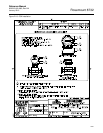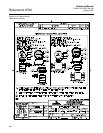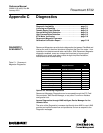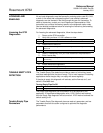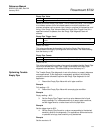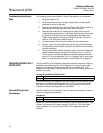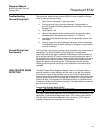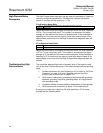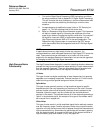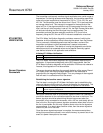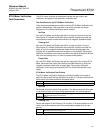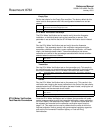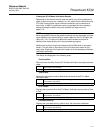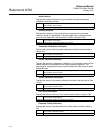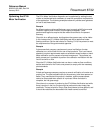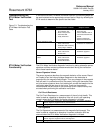
Reference Manual
00809-0100-4663, Rev BA
January 2010
C-7
Rosemount 8732
1. Turn on the Digital Signal Processing (DSP) technology and follow
the setup procedure (refer to Appendix D: Digital Signal Processing).
This will minimize the level of damping in the flow measurement and
control loop while also stabilizing the reading to minimize valve
actuation.
2. Increase damping to stabilize the signal (refer to “PV Damping” on
page 3-11). This will add dead-time to the control loop.
3. Move to a Rosemount High-Signal flowmeter system. This flowmeter
will deliver a stable signal by increasing the amplitude of the flow
signal by ten times to increase the signal to noise ratio. For example if
the signal to noise ratio (SNR) of a standard magmeter is 5, the
High-Signal would have a SNR of 50 in the same application. The
Rosemount High-Signal system is comprised of the 8707 sensor
which has modified coils and magnetics and the 8712H High-Signal
transmitter.
NOTE
In applications where very high levels of noise are a concern, it is
recommended that a dual-calibrated Rosemount High-Signal 8707 sensor be
used. These sensors can be calibrated to run at lower coil drive current
supplied by the standard Rosemount transmitters, but can also be upgraded
by changing to the 8712H High-Signal transmitter.
High Process Noise
Functionality
The High Process Noise diagnostic is useful for detecting situations where the
process fluid may be causing electrical noise resulting in a poor measurement
from the magnetic flowmeter. There are three basic types of process noise
that can affect the performance of the magnetic flowmeter system.
1/f Noise
This type of noise has higher amplitudes at lower frequencies, but generally
degrades over increasing frequencies. Potential sources of 1/f noise include
chemical mixing and the general background noise of the plant.
Spike Noise
This type of noise generally results in a high amplitude signal at specific
frequencies which can vary depending on the source of the noise. Common
sources of spike noise include chemical injections directly upstream of the
flowmeter, hydraulic pumps, and slurry flows with low concentrations of
particles in the stream. The particles bounce off of the electrode generating a
“spike” in the electrode signal. An example of this type of flow stream would
be a recycle flow in a paper mill.
White Noise
This type of noise results in a high amplitude signal that is relatively constant
over the frequency range. Common sources of white noise include chemical
reactions or mixing that occurs as the fluid passes through the flowmeter and
high concentration slurry flows where the particulates are constantly passing
over the electrode head. An example of this type of flow stream would be a
high consistency pulp stock stream (>10%) in a paper mill.



